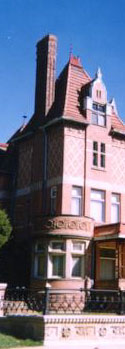Existing Masonry Chimneys
10/8/14

|
The question of whether or not to maintain, repair or restore a masonry chimney should be answered clearly with a resounding YES.
|
|
In the 1980's and new UL standard was developed - UL1777 which basically called for an insulated lining system that would make a masonry chimney in contact with combustable materials as safe as a chimney built to code with a 2" air space clearance to combustibles. Trouble is the insulated liners are 1/2" to 1" thick and necessarily reduct the size of the flue to the point that it might not be large enough to vent the appliance it's intended to vent. For this reason alone it may be smart to consider alternatives to re-lining a chimney with a UL listed liner. Consider, for example, that a UL listing does not make a product or method safe. It just shifts the responsibility from the building official to the private company that manufactures or installs the listed product. Given that many UL1777 lining systems are installed without the required insulating blanket which, of course, voids the listing may just mean the installer has decided the insulation is not really needed. Should the installer or the building official make that decision? We have seen that thickness and mass historically worked well as a fire prevention strategy and we have seen that many builders just ignore the air space requirement. So let's see a UL 1777 listed liner as just one alternative way - especially for stoves - to make an old or not-in-compliance-with-code chimney safe. But for fireplaces, which rarely cause chimney fires, UL listed insulating flue liners may make the flues too small to use with the fireplaces. Mortar voids and cracked flue liners So what can be done about voids in the mortar joints between clay flue liners or cracks in the liners themselves?
|
 |
|
First let's understand the physics. A hole clear through a chimney would suck air into the chimney - not blow products of combustion out - because the rising column of hot flue gasses creates lower pressure which is how a chimney draws. So a crack in the flue or a mortar void is not likely to be a fire hazard - especially if it's not even in the vicinity of any combustible material. Actually a flaw in a flue is not a new problem. And there are ways to fill mortar voids and cracked flue liners from franchised systems that wipe or spray refractory mortar into the voids to simply doing that where needed with a sponge or trowel even if an access hole has to be made by removing a few bricks.
|
 |
Seismic Issues Then there are earthquakes. You may not have many in St. Louis but you had a really big one in 1812. And the code now includes soil and seismic maps that make some areas seismic areas even in regions where no seismic reinforcing was required a few years ago. We have had a few earthquakes in the West and the industry evaluated all of them. what we found was that ...
|

Chimney Training Index
<<< BACK - Energy & Ventilation -
NEXT - Exam >>>
Buckley Rumford Fireplaces
Copyright 1995 - 2014 Jim Buckley
All rights reserved.
